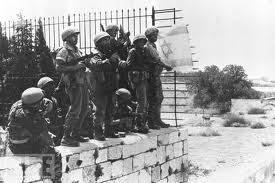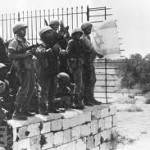The first radio reports came through from the Jerusalem front on that hot day in June, 1967. The reporter was breathing hoarsely as he ran with the soldiers entering Lion’s Gate. The sniper fire in the background did not seem to faze either the reporter or the soldiers. The reporter’s microphone did not pick up anxious cries of “take cover” or “stay close to the buildings”. What you heard instead was the excitement as one soldier asked the other, “where is it?” or “which way to the Kotel (the Western Wall).One could pick up the sense of determination as soldiers were running ,intent on getting “somewhere”. And then , General Motta Gur announced over his radio the words that were waiting to be spoken for 2000 years , “Har Habayit BeYadeinu the Temple Mount is in our hands… I repeat, The Temple Mount is in our hands”.
If one takes a cursory and objective glance at the recent history of the people of Israel and the rebirth of a Jewish commonwealth in the land of Israel, one cannot escape its resemblance to classical biblical text. An oppressed, dispersed and maligned people ingathered to their ancient homeland. A small and beleaguered nation succeeds in fighting off multiple nations’ intent on their destruction. And then a two thousand year old yearning to return to their beloved Jerusalem and the Temple Mount is fulfilled in the midst six miraculous days.
The Temple Mount is the holiest location in the universe according to Jewish understanding. It was from there that the world expanded into its present form, and it was there where Hashem gathered the earth used to create man. The Torah tells us that HaShem chose to rest His Divine Presence, in that location forever and that two Jewish Temples were built there . According to the prophecies of the Bible , the Third Temple will also be located here, and will eventually become the eternal House of Prayer for all nations (Isaiah 1:2-3; Ezekiel . 37:26-28; 40-48;Micah . 4:1-2; Haggai. 2:7-9;and Zechariah 6:12-15; 14:20)
The world, though, and especially the Muslim world have yet to learn to digest, cope and accept that reality. Many of these nations, regrettably, will struggle against this city’s destiny to the very end, as Zachariah proclaims;
“Behold, I will make Jerusalem a cup of drunkenness to all the surrounding peoples, when they lay siege against Judah and Jerusalem . And it shall happen in that day that I will make Jerusalem a very heavy stone for all peoples; all who would try to heave it away will surely be cut in pieces, though all nations of the earth are gathered against it.” ( Zechariah 12:2-3)
Yet most dramatically it is first the Jewish people that need to rekindle the yearning for that holy place. It is true that General Motta Gur’s declaration that “the Temple Mount is in our hands” stirred the soul of every Jewish person of that time .Yet over time the sound of that declaration has dimmed and has remained but a whisper. It was again due to that same “abused child syndrome” that has characterized Jewish existence through exile that the Temple mount was quickly abandoned and given over to the Moslem Waqf. The essence of this “syndrome” is that the victim of abuse and persecution begins to believe that the victim himself is responsible for the abuse. As a result the victim will do everything to minimize his own identity and unique character. Therefore it was important for Moshe Dayan to give the keys to the Temple Mount to the Muslims in an attempt to show how “nice and good” the Israeli people truly are. As a result Motta Gur’s declaration remains a distant bittersweet memory.
Yet the memory has not been erased. The yearning for the place of G-d’s House continues to resonate in the heart of many. The Mount does not have to be liberated in warfare and the Temple clearly will be rebuilt when the world is ready for it. It will happen when “the knowledge of G-d will cover the earth like water over the sea” ( Isaiah 11)and all men will join in its rebuilding. Yet it is first the yearning that will ensure the unfolding of these events.
In Psalm 122 King David writes “I rejoiced with those who said to me,“Let us go up to the house of HaShem. Our feet are standing in your gates, Jerusalem.( Psalm 122:1-2)
Shouldn’t it have said” I rejoiced as we went to the house of HaShem ?”. Yet King David was not destined to rebuild the Temple but he rejoiced nevertheless when he heard of the blossoming and growing yearning of those who cried out ““Let us go up to the house of HaShem”.
It is that “yearning” that is the foundation upon which prophetic destiny is built and becomes fulfilled. This explains another verse in the same psalm;
“Pray for the peace of Jerusalem:” (psalm 122:6).
The word in Hebrew used for prayer is unique in this verse. Shaalu is rooted in the word for “ask for”. That is to say “Ask for and yearn and desire the peace of Jerusalem”. the Hebrew word for Peace is Shalom. That word is rooted in the concept of being whole and complete ( Shalem) Jerusalem can only be a true vessel of peace if it remains a vessel unbroken and complete.
That is the essence of the passion of those tens of thousands of young and old who will fill the streets of Jerusalem in celebration of Yom Yerushalyim ( Jerusalem Day). It is that yearning that will be audibly heard in their prayers and their songs. It is the underpinnings of all those across the world who yearn to fulfill the verse ” Shaulu Shlom Yerushalayim , Pray for the Peace of Jerusalem

